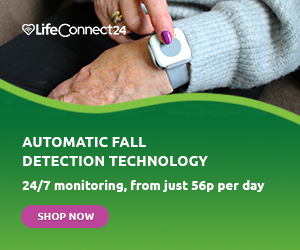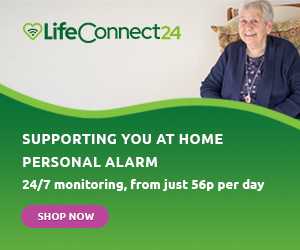As the days get shorter and the cold weather draws in, lots of people will experience seasonal affective disorder (SAD). Many of us find it difficult to talk about mental health – or even to recognise when we’re struggling ourselves. Older people in particular might be reluctant to seek help for conditions like SAD. In fact, around 85% of older people with depression don’t receive help from the NHS, according to the Mental Health Foundation.
Today, we’ll be taking a look at seasonal affective disorder. We’ll explain what it is, who it affects, and the common treatments available. We’ll also share some tips for looking after your own mental health and supporting a loved one who is struggling.
What Is Seasonal Affective Disorder?
Seasonal affective disorder (or SAD) is a form of depression that occurs in a seasonal pattern. You might also hear people calling it ‘seasonal depression’ or ‘the winter blues’. Usually, it flares up in the winter months and fades again in springtime. In some cases, however, symptoms can appear during the summer and go away in winter.
What Causes SAD?
While we don’t know precisely what causes SAD, one theory is that we might feel lower in winter because we spend less time in sunlight. Daylight plays a key role in the body’s production of certain hormones. When the days get shorter, our bodies produce more melatonin and less serotonin. Melatonin makes us feel sleepy; the body starts producing melatonin when it gets dark outside. Serotonin, on the other hand, wakes us up and affects both mood and appetite. Production of serotonin is linked to sunlight, which is why we might produce less in winter.
On the other hand, those who experience seasonal affective disorder in summer might not produce enough melatonin and might therefore struggle to get to sleep at all.
Symptoms of SAD
Here are the most common signs of seasonal affective disorder:
- Low mood
- A change to your sleeping pattern – either sleeping/feeling sleepy all the time or struggling to get to sleep
- Lack of energy
- A change in your eating habits – either overeating or undereating and resulting weight gain/loss
- Feeling irritable
- Not wanting to do the things you normally like doing
- Problems concentrating or remembering
Naturally, everybody will have a slightly different experience of seasonal affective disorder (just like any mental health condition). You might not experience all of the above symptoms. Nevertheless, if something doesn’t feel right, it’s always worth making an appointment with your GP.
Who Is At Risk Of Seasonal Affective Disorder?
Anybody can experience seasonal affective disorder. However, there are a few groups of people who might be more prone to developing symptoms.
Age
Most people receive a diagnosis between the ages of 18 and 30. However, this is not to say that older people do not experience seasonal affective disorder. Rather, they might be more reluctant to come forward and seek diagnosis or treatment.
Gender
Most people who suffer from SAD are women – around 3 in 4. In contrast, some men experience more severe symptoms. As with age, it is difficult to say whether men are less likely to suffer with SAD or just less likely to seek support for it.
Family History
If any of your relatives have experienced seasonal affective disorder or any other forms of depression, you might be more likely to develop SAD.
Treatment for Seasonal Affective Disorder
Treatment for seasonal affective disorder is essentially the same as for any other kind of depression. To learn more about general treatments for depression, read our helpful guide. There are also a few additional treatments that are specific to SAD.
Light Therapy
Some people use special light boxes to simulate daylight and counteract the causes of SAD. This light therapy is popular, although the National Institute for Health and Care Excellence says it’s not completely clear whether it’s effective.
Light boxes for SAD are not usually available on the NHS, so you may wish to buy one yourself. They produce a bright light, which should encourage the brain to reduce its production of melatonin and increase serotonin levels. You will normally need to sit by the light box for 30-60 minutes each morning in order to notice the effects. Fortunately, these light boxes are able to filter harmful UV rays out of the light they produce, so there are none of the normal risks you might associate with direct sunlight.
Does Vitamin D Help?
Alongside regulating our moods and sleep cycles, sunlight is also an important source of vitamin D. Of course, we have less exposure to sunlight in winter, and therefore we receive less vitamin D. For this reason, some people take vitamin D supplements to treat seasonal affective disorder. We also get vitamin D from our diets – foods like oily fish, egg yolks, and fortified breakfast cereals are good sources. For more nutrition advice, have a look at the Eatwell Guide.
There have been several studies into the effectiveness of vitamin D to treat seasonal affective disorder, with mixed results. If you think you might have SAD, you should talk to a doctor before taking any supplements or medication.
Mental Health Tips for Winter
Whether you are suffering from the winter blues yourself or you want to a support a loved one with SAD, here are our top tips for looking after mental health in winter.
Get Some Sunlight
Since sunlight is in relatively short supply in the wintertime, it’s important to grab it where you can. A short walk at lunchtime is a great idea. Going outside every day, even briefly, is generally very good for mental health. Walking is also a great form of exercise. If you’re not a fan of walking, why not consider a bike ride instead? If it’s too cold to go outside, try and let as much light into your home as you can. Open any blinds and curtains and sit near a window when reasonable.
Get Moving
Regular physical activity can help to relieve symptoms of depression, including the symptoms of seasonal affective disorder. We’ve got plenty of exercise ideas here on the LifeConnect24 blog. Check out our top 7 sport and fitness activities for older people.
Get Talking
Loneliness is already a huge problem for older people in the UK. If you have SAD, you might feel especially isolated or lonely. That’s why it’s so important to reach out to the people around you. If you aren’t able to meet up in person, don’t worry. Why not call a relative on the phone, write a letter to a friend, or have a quick chat with a neighbour? There are also various social media options to help you keep in touch.
In addition, people over the age of 60 can use Age UK’s Call in Time service. This scheme pairs you with a like-minded volunteer for weekly chats over the phone. They also offer a free 24-hour helpline for those who want advice, support, or just a friendly chat.
Get Cosy
Wintertime might take its toll on mental health, but there are still things to love about the colder months. Dig out your favourite jumper and a fluffy pair of socks. Tuck yourself up with a cosy blanket and watch your favourite film or read a good book. Make a nice, hearty stew or a mug of hot cocoa.
Get the Help You Need
Most importantly, if you have any concerns at all about your mental health, make sure to get some support. Make an appointment with your GP – telephone appointments are often available if you need one. A doctor will be able to get you the help you need. This could be talking therapy (such as cognitive behavioural therapy) or antidepressant medication.
Stay Safe This Winter
Whether you suffer from seasonal affective disorder or not, winter can be a difficult time. Falls are a prominent concern for many older people, particularly in the colder months with rainy and icy conditions. A Lifeline alarm is a great way to stay safe and independent with peace of mind. Our personal alarms keep you safe at home; as well as our standard alarm and pendant, we also offer the automatic fall detector plan.
For more information on any of our life-saving alarms, please don’t hesitate to get in touch. You can call us anytime on 0800 030 8999 or send us an email to info@lifeconnect24.co.uk. Alternatively, you can fill in a brief contact form to request a call back at your convenience. You can order your personal alarm online or give us a call.
Don’t forget, more than 95% of our customers are eligible for VAT exemption and pay no VAT whatsoever on their Lifeline alarms. See our guide to VAT exemption to find out if you qualify.
Editor’s Note: This article was updated on 12th January 2024 to reflect current information.



Leave A Comment